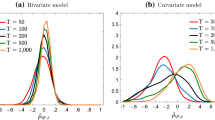Abstract
When applied to monthly age specific data, Granger-Sims causality tests provide a useful technique for identifying the effective lag between business cycles and fertility in the United States. Male and female monthly age specific unemployment rates are used as a proxy for the business cycle, and test results are presented for first and higher order birth rates, as well as total age-specific monthly fertility rates. The period is subdivided (January 1958 – May 1973 and June 1973 – December 1984) in order to identify possible trends. Four results hold in all cases studied, with respect to the relationship between unemployment and fertility. (1) Noncausality is rejected in the direction from unemployment to fertility, and no ‘feedback’ effect is indicated; thus the relationship is one of simple causality. (2) In the ‘critical’ decision period from 9–16 months prior to realized fertility rates, the sign of the effect of unemployment on fertility is negative: this holds for both male and female unemployment rates. (3) There appears to have been a shortening of the effective lag between unemployment and fertility, of perhaps 2 – 3 months, between periods 1 (1959 – 1973) and 2 (1973 – 1984). (5) The strength of the (negative) relationship between unemployment and fertility appears to have increased from period 1 to period 2.
Similar content being viewed by others
References
Becker GS (1960) An economic analysis of fertility. In: Demographic and economic change in developed countries, NBER, Conference Series II. Princeton University Press, Princeton, New Jersey
Ben-Porath Y (1973) Short-term fluctuations in fertility and economic activity in Israel. Demography 10:185–204
Butz WB, Ward MP (1979) The emergence of countercyclical U.S. fertility. Am Econ Rev 69:318–28
Fuller WA (1976) Introduction to statistical time series. John Wiley, New York
Galbraith VL, Thomas D (1941) Birth rates and the interwar business cycles. J Am Stat Assoc 36:465–476
Geweke J (1982) Causality, exogeneity, and inference. In: Hildenbrand W (ed) Advances in econometrics. Cambridge University Press, New York
Geweke J, Meese R, Dent W (1983) Comparing alternative tests of causality in temporal systems. J Economet 21:161–194
Guilkey DK, Salemi MK (1982) Small sample properties of three tests for Granger-causal ordering in a bivariate stochastic system. Rev Econ Statist 64:668–680
Hexter MB (1925) Social consequences of business cyclesHoughton MifflinBoston, Massachusetts
Kelly WR, Cutright P (1984) Economic and other determinants of annual change in U.S. fertility: 1917–1976. Soc Sci Res 13:250–267
Kirk D (1960) The influence of business cycles on marriage and birth rates. In: Demographic and economic change in developed countries. NBER, Conference Series II. Princeton University Press, Princeton, New Jersey
Krämer W, Neusser K (1984) The emergence of countercyclical U.S. fertility: Note. Am Econ Rev 74:201–202
McDonald J (1983) The emergence of countercyclical U. S. fertility: a reassessment of the evidence. J Macroecon 5:421–436
Silver M (1965) Births, marriages and business cycles in the United States. J Polit Econ 73:221–255
Thomas DS (1927) Social aspects of the business cycle. Alfred A Knopf, New York
Thomas DS, Galbraith VL (1956) Birth rates and interwar business cycles. In: Spengler JJ, Duncan OD (eds) Demographic analysis. Free Press, Glencoe, Illinois
Yule GU (1906) On changes in the marriage- and birth-rates in England and Wales during the past half century. J R Statist Soc 69:88–132
Author information
Authors and Affiliations
Rights and permissions
About this article
Cite this article
Macunovich, D.J., Easterlin, R.A. Application of Granger-Sims causality tests to monthly fertility data, 1958–1984. J Popul Econ 1, 71–88 (1988). https://doi.org/10.1007/BF00171511
Received:
Accepted:
Issue Date:
DOI: https://doi.org/10.1007/BF00171511




